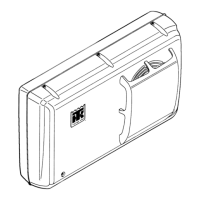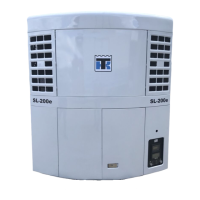Electrical Maintenance (Rev 1/99)
36
Defrost Termination Switch Bench Test
1. Connect a test light between the screw terminal on the
switch and the positive battery terminal.
NOTE: Attempting to test the electronic defrost ter-
mination switch with an ohmmeter is generally not
satisfactory because of the low voltage available at the
meter leads.
2. Connect the ground wire of the switch to the negative
battery terminal.
3. Raise the temperature of the defrost termination switch
above 52 F (11.1 C). The light should be off, indicating
an open switch.
4. Cool the defrost termination switch below 42 F (5.6 C).
The light should come on, indicating the switch has
closed.
NOTE: Allow adequate time for the temperature
change to saturate the defrost termination switch
before performing the test.
Defrost Relay
The defrost relay controls the operation of the defrost cycle.
When the defrost timer or the Manual Defrost key com-
pletes the circuit through the defrost termination switch to
ground, the defrost relay is energized. This energizes the
hot gas solenoid and de-energizes the fan relay. The defrost
relay stays energized until the defrost cycle is terminated by
the defrost termination switch or the defrost timer.
Hot Gas Solenoid
The hot gas solenoid is a normally closed solenoid valve
that controls the flow of refrigerant through the refrigeration
system. The hot gas solenoid opens when it is energized by
the defrost relay. This causes most of the hot gas refrigerant
to bypass the condenser and flow directly to the evaporator,
where it heats the evaporator coil.
V250 Defrost System and P.C. Board
Identification and Testing
The V250 defrost system energizes a hot gas defrost sole-
noid valve (HGV) to route hot gas through the evaporator
coil. This method of defrosting the evaporator coil is used
for over the road operation, and for electric operation on
units equipped with electric standby.
The electrical controls in the defrost system consist of the
following items:
1. The manual defrost switch and defrost LED located in
cab control box.
2. The defrost termination switch (ETS) mounted on the
evaporator coil.
3. The printed circuit (P.C.) board located in the low volt-
age box in the condenser.
4. The associated wiring.
Pressing the manual defrost switch in the cab control box
applies 12 volts to the 11 circuit, which is connected to the
P.C. board in the low voltage box. The defrost LED is ener-
gized through the 11 circuit and grounded through the 12
circuit.
The defrost termination switch grounds the 12 circuit to a
chassis ground when it closes. The defrost termination
switch closes when the temperature drops below 42 F. It
opens when the temperature rises above 52 F.
The P.C. board contains the following items that are part of
the defrost system:
1. The defrost relay (DR).
2. The defrost relay LED (PL7).
3. The timing chip for the timed defrost interval (defrost
initiation timer).
4. The adjustable potentiometer (R16/R17) used to adjust
the timed defrost interval.
5. The fast clock jumper (W2) used to speed up the timed
defrost interval for testing.

